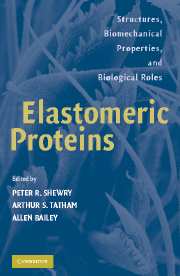Book contents
- Frontmatter
- Contents
- Preface
- Contributors
- Elastomeric Proteins
- 1 Functions of Elastomeric Proteins in Animals
- 2 Elastic Proteins: Biological Roles and Mechanical Properties
- 3 Elastin as a Self-Assembling Biomaterial
- 4 Ideal Protein Elasticity: The Elastin Models
- 5 Fibrillin: From Microfibril Assembly to Biomechanical Function
- 6 Spinning an Elastic Ribbon of Spider Silk
- 7 Sequences, Structures, and Properties of Spider Silks
- 8 The Nature of Some Spiders' Silks
- 9 Collagen: Hierarchical Structure and Viscoelastic Properties of Tendon
- 10 Collagens with Elastin- and Silk-like Domains
- 11 Conformational Compliance of Spectrins in Membrane Deformation, Morphogenesis, and Signalling
- 12 Giant Protein Titin: Structural and Functional Aspects
- 13 Structure and Function of Resilin
- 14 Gluten, the Elastomeric Protein of Wheat Seeds
- 15 Biological Liquid Crystal Elastomers
- 16 Restraining Cross-Links in Elastomeric Proteins
- 17 Comparative Structures and Properties of Elastic Proteins
- 18 Mechanical Applications of Elastomeric Proteins – A Biomimetic Approach
- 19 Biomimetics of Elastomeric Proteins in Medicine
- Index
12 - Giant Protein Titin: Structural and Functional Aspects
Published online by Cambridge University Press: 13 August 2009
- Frontmatter
- Contents
- Preface
- Contributors
- Elastomeric Proteins
- 1 Functions of Elastomeric Proteins in Animals
- 2 Elastic Proteins: Biological Roles and Mechanical Properties
- 3 Elastin as a Self-Assembling Biomaterial
- 4 Ideal Protein Elasticity: The Elastin Models
- 5 Fibrillin: From Microfibril Assembly to Biomechanical Function
- 6 Spinning an Elastic Ribbon of Spider Silk
- 7 Sequences, Structures, and Properties of Spider Silks
- 8 The Nature of Some Spiders' Silks
- 9 Collagen: Hierarchical Structure and Viscoelastic Properties of Tendon
- 10 Collagens with Elastin- and Silk-like Domains
- 11 Conformational Compliance of Spectrins in Membrane Deformation, Morphogenesis, and Signalling
- 12 Giant Protein Titin: Structural and Functional Aspects
- 13 Structure and Function of Resilin
- 14 Gluten, the Elastomeric Protein of Wheat Seeds
- 15 Biological Liquid Crystal Elastomers
- 16 Restraining Cross-Links in Elastomeric Proteins
- 17 Comparative Structures and Properties of Elastic Proteins
- 18 Mechanical Applications of Elastomeric Proteins – A Biomimetic Approach
- 19 Biomimetics of Elastomeric Proteins in Medicine
- Index
Summary
INTRODUCTION
The spatial organization of acto-myosin contractile machine varies widely in different muscle cells. Each of the major muscle types – smooth, oblique-, and cross-striated – has versions differing in myosin/actin ratio, myofilament size, accessory proteins, and overall level of structural order. These variations relate directly to functional differences of the muscles, especially their speed and strength of contraction. The greatest structural order is in cross-striated muscles, and highest myosin/actin ratio is in striated muscles of vertebrates. These have exactly structured myofilaments integrated into highly ordered contractile units: the sarcomeres. This beautifully controlled architecture provides the basis for highly coordinated acto-myosin interactions and for the rapid production of macroscopic levels of force and displacement.
The giant protein titin is thought to play a pivotal role in defining and maintaining structural order in vertebrate striated muscle. The properties of the titin molecule allow it not only to be a centrepiece of contractile protein assembly, but also to control the level of mechanical sensitivity and elasticity of the sarcomere. This chapter describes some of the recent ideas concerning the relationship between structural and mechanical properties of single titin molecules and how these properties integrate to determine muscle function (see also reviews by Trinick, 1994, 1996; Wang, 1996; Linke and Granzier, 1998; Gautel et al., 1999; Trinick and Tskhovrebova, 1999; Gregorio and Antin, 2000).
- Type
- Chapter
- Information
- Elastomeric ProteinsStructures, Biomechanical Properties, and Biological Roles, pp. 242 - 258Publisher: Cambridge University PressPrint publication year: 2003

